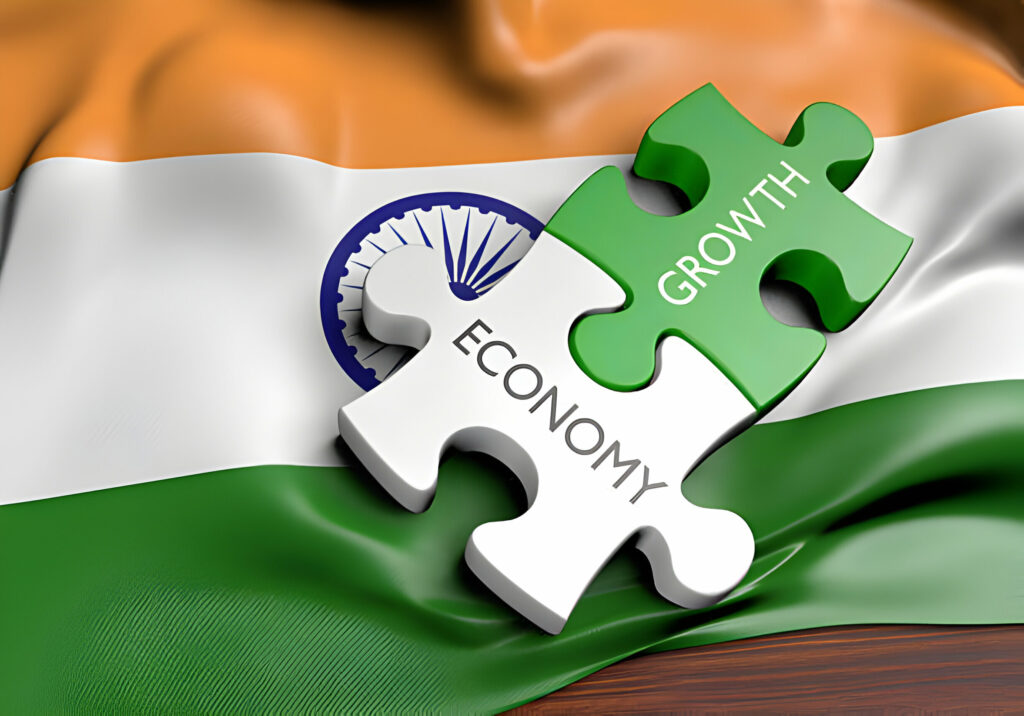In the grand chessboard of global economics, a new king is poised to emerge, potentially altering the balance of power in ways not seen for centuries. For decades, China has stood unchallenged as the burgeoning economic behemoth, dictating the pace and direction of global trade flows, technological innovation, and manufacturing supremacy. Yet, as the world inches closer to 2028, a wind of change is blowing from the south, with India demonstrating all the hallmarks of an economic titan in the making, ready to challenge China’s longstanding dominion.

Image Credit: Kagenmi from iStock.com
Table of Contents
India's Path to Economic Preeminence
India’s trajectory toward economic preeminence is not a matter of chance but a consequence of deliberate policy, demographic dividends, and technological leapfrogging. With a population exceeding 1.3 billion, India is poised to surpass China as the world’s most populous country. This demographic milestone, however, is not just a numerical victory; it heralds a vibrant, young workforce ready to fuel India’s economic engines. Unlike China, where the aging population has become a pressing concern, India’s median age is a youthful 28 years, suggesting a long runway for growth fueled by human capital.
Technology and innovation are at the heart of India’s economic ascendancy. With one of the world’s fastest-growing digital economies, India has made significant strides in digitization, from mobile payments to online education, fostering an environment ripe for technological innovation and entrepreneurship. The government’s push towards digital infrastructure, demonstrated through initiatives like Digital India, has not only bridalled the urban-rural divide but also attracted foreign investment keen on tapping into India’s burgeoning market.
India has been strategically diversifying its economic portfolio. While China’s economic might is heavily concentrated in manufacturing and exports, India’s growth is more multifaceted, spanning services, IT, telecommunications, and now increasingly, manufacturing, thanks to initiatives like ‘Make in India‘. This economic diversification renders India less susceptible to the fluctuations of global trade dynamics, providing a more stable path to economic growth.
India’s ascendancy is also being facilitated by geopolitical shifts. The receding allure of China as the world’s factory, precipitated by trade tensions with the US and other Western countries, has benefitted India. Companies looking to de-risk their supply chains are increasingly turning to India as a viable alternative, bolstered by its democratic governance and policy reforms aimed at improving ease of doing business.
However, the road to overtaking China as the world’s economic heavyweight is strewn with challenges. Infrastructure, healthcare, and education are areas where India needs to accelerate improvement to harness its full economic potential. Additionally, environmental sustainability and climate change pose significant hurdles to rapid industrialization, necessitating a balanced approach to growth.
While hurdles remain, India’s path to economic preeminence seems both clear and attainable. By leveraging its demographic advantages, embracing technological innovation, and diversifying its economic base, India is not just dreaming of becoming the world’s next economic heavyweight by 2028—it is steadily marching towards it. As we stand on the cusp of what could be the dawning of a new era, the global economic landscape looks set to be redefined, with India leading the charge.
Is It India's Turn to Be the World’s Next Growth Driver?
As the global economic landscape evolves, the question looms: Can India step into the shoes once filled by China, the world’s factory and a juggernaut of economic growth? This question gains heft in the backdrop of China’s economic slowdown and the West’s growing perception of it more as a rival than a partner. Amid these shifts, India emerges as a potential contender, buoyed by optimism and strategic moves that hint at its readiness to be the next global growth engine.
A recent Bloomberg report shines a light on the burgeoning Indian stock market, lifted by foreign investments and bolstered by the government’s new trade agreements. The allure of India’s market is undeniable, with its 1.43 billion-strong consumer base gaining attention from international corporations that are diversifying their manufacturing bases away from China.
Notably, aviation giants like Boeing have clinched record orders from Indian carriers, including Air India and IndiGo, in a clear signal of the sector’s booming prospects. Meanwhile, Apple Inc.’s decision to ramp up its production of iPhones on Indian soil underscores the tech sector’s burgeoning confidence in India’s capabilities.
The momentum is palpable, propelled by international manufacturers’ growing penchant for India’s market, which once almost exclusively revolved around southern China. This pivot is not just a testament to changing global economic dynamics but also a reflection of India’s strategic positioning and policy frameworks that resonate with global business leaders.
However, the journey is not without its challenges. Despite the promise and potential, India’s $3.5 trillion economy is still significantly smaller compared to China’s $17.8 trillion behemoth. Economists argue that the path to matching, let alone surpassing, China’s economic prowess is steep, marred by infrastructural deficiencies, educational gaps, bureaucratic hurdles, and a lack of skilled labor. These are not small hurdles and represent systemic issues that require concerted effort and visionary policy-making to overcome.
Yet, the narrative is not all gloomy. India’s demographic dividend, characterized by its young and vibrant workforce, combined with a steady stream of reforms and initiatives aimed at improving infrastructure, education, and ease of doing business, sets the stage for a transformative growth story. The nation’s digital leap, seen through initiatives like Digital India and a rapidly growing startup ecosystem, adds to the optimism.
While India may not immediately displace China as the world’s next growth driver, the foundations are being laid for a significant global economic role. The transformation will require patience, strategic planning, and an unwavering commitment to reform. As India charts its course through these challenges, the possibility of it becoming a key player in the global economic landscape becomes increasingly plausible. The next chapter of India’s growth story, amidst the shifting sands of global economics, is poised to be riveting.
How Can India Surpass China?
Amidst the swirling currents of global economic forecast, a notable prediction stands out: India’s burgeoning potential to overtake China as the primary engine of global economic growth. With bullish outlooks from investment giants like Barclays and analytical optimism from Bloomberg Economics, the horizon seems promising for India. Yet, this ascent requires meticulous strategy, particularly in four pivotal development areas.
1. Enhancing Infrastructure:
At the forefront of this monumental task lies the challenge of building robust infrastructure. India’s aspiration to spearhead global economic growth is tethered to its ability to construct a modern infrastructure network. This encompasses everything from transportation corridors that stitch together the vast nation to digital highways that connect its burgeoning tech hubs. Efficient, reliable infrastructure is the skeleton upon which the muscle of economic activity flexes.
2. Workforce Skill Development and Participation:
The soul of any economy is its workforce. For India, the task is twofold: significantly enhancing the skill set of its workforce while simultaneously increasing participation. This means not only investing in education and vocational training at unprecedented levels but also removing barriers to employment for women and marginalized communities. The aim is to create a workforce that’s not just larger, but smarter, more skilled, and more innovative.
3. Urbanization and City Development
India’s urban landscape must evolve to accommodate and nurture the burgeoning workforce poised to drive its economic engine. Developing better cities — ones that offer affordable housing, efficient public transportation, and sustainable environmental practices — is essential. These urban centers must become beacons of opportunity, attracting workers while simultaneously offering a quality of life that retains them.
4. Industrial Expansion:
Lastly, to sustain and accelerate this growth trajectory, India must become a magnet for manufacturing. Drawing more factories entails not just improving ease of doing business, but also offering incentives that stand apart on the global stage. By enhancing its manufacturing sector, India can create jobs, boost exports, and deepen its integration into global supply chains.
As Bloomberg Economics’ analysis suggests, achieving these lofty goals could position India to surpass China as the world’s top contributor to GDP growth by 2028. However, this is no small feat. It demands concerted efforts from both the government and the private sector, alongside a commitment to reform and innovation.
India's Economic Ascent: Navigating the Post-China "Miracle" Landscape
The transformative journey of China’s economy over the last few decades has been nothing short of phenomenal. Following pivotal reforms in the late 1970s, China witnessed an unprecedented average annual economic growth rate of 10%. This monumental growth not only attracted foreign capital in droves but also solidified China’s influence on the global stage. However, the awe-inspiring era of China’s economic “miracle” appears to be receding, overshadowed by a property crisis and mounting apprehensions in the West regarding China’s domination in supply chains and technological innovation.
In the face of these challenges, India, under the leadership of Prime Minister Narendra Modi, is steadily emerging as a beacon of economic competitiveness. According to a Bloomberg report, this shift is capturing the attention of Western businesses eager to mitigate risks associated with China by tapping into India’s vast labor pool.
Central to PM Modi’s administration is the ambition to catapult the Indian economy to unprecedented heights, a vision he robustly championed during an election rally last year. With promises of economic dominance, Modi’s vision includes a strategic overhaul of India’s infrastructure, with public spending allocated to infrastructure soaring to over ₹11 lakh crore (₹11 trillion) for the fiscal year 2024-2025. This expenditure is anticipated to reach even more staggering heights, possibly exceeding ₹20 lakh crore (₹20 trillion) with the addition of state funds.
Projected long-term investments amount to an eye-watering ₹143 lakh crore (₹143 trillion) over six years up to 2030, targeting enhancements in railways, roadways, ports, and other vital areas. Concurrently, to curb inflation, the Modi government has imposed bans on the exports of essential staples such as wheat and rice.
In a move to bolster domestic manufacturing, the Indian government rolled out incentive programs worth approximately ₹2.7 lakh crore (₹2.7 trillion), offering attractive tax breaks, subsidized land rates, and capital injections to incentivize the establishment of manufacturing facilities in India by various companies.
Bloomberg Economics presents an optimistic forecast for India, predicting an acceleration of its economy to 9% by the end of the decade, while China’s growth rate is expected to decelerate to 3.5%. This trajectory envisions India surpassing China as the primary global growth engine by 2028 — and even under the most conservative estimates, India is poised to overtake China by 2037.
India’s unique position as a country with a vast population capable of meeting the demand for medium-skilled labor — crucial for manufacturing — further strengthens its potential to absorb the workforce retiring from China and other advanced economies. With projections indicating that India will add 38.7 million medium-skilled workers from 2020 to 2040, the nation is set to become an indispensable hub in the global economic landscape.
As the dusk falls on China’s economic “miracle,” India’s rise presents a new chapter in the narrative of global economic dynamics, anchored by strategic reforms, monumental investment in infrastructure, and an unwavering commitment to becoming a central pivot in the world economy.





























